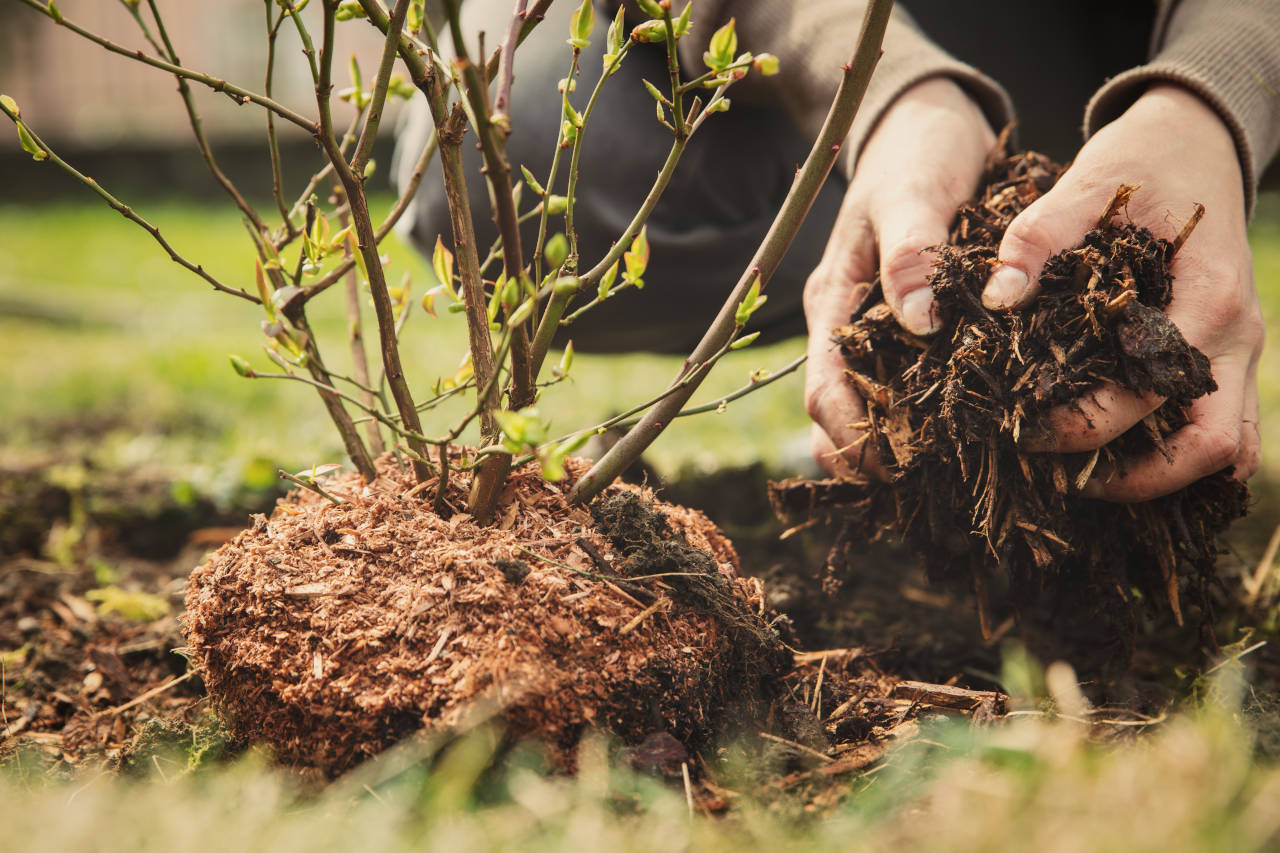Cost to Install Mulch – 2025 Price Guide
Mulch is often used in landscaping to add beauty to flower beds, keep weeds at bay, and add nutrients and water to the soil. It may be made of shredded bark, or it may be made from one of many different organic or inorganic materials like straw, pebbles, or rocks.
You might be wondering how much it costs to install mulch to your landscaping, and we'll cover that in detail below.
2025 Landscape Mulch Costs
Calculate local project costs by entering your zip code.
Custom Location
| Average Price (per yard - installed) | $325 |
| Typical Price Range (per yard - installed) | $210 - $400 |
Get free estimates from contractors near you.
On this page:
- How Much Does Mulch Landscaping Cost?
- Types of Mulch
- Organic Mulch
- Shredded Bark
- Grass Clippings/Leaves
- Compost
- Hemlock Bark Mulch
- Inorganic Mulch
- Plastic
- Rubber
- Geotextiles or Landscape Fabric
- Gravel, Stone, and Rocks
- Mulch Coverage Estimate
- Mulch Price Per Yard Estimates
- Average Mulch Prices
- A Ballpark Figure for Mulch
- References
How Much Does Mulch Landscaping Cost?
Mulch is a landscaping aid that may be organic or inorganic, and it impedes the growth of weeds and helps the soil retain moisture. Although many people think organic mulch, like shredded bark, is better, don’t discount inorganic mulch just yet, there are some excellent reasons to use these.
There are many varieties of mulch available depending on your needs and budget. A properly mulched garden will require less watering, weeding, and pest control spraying.[1]
A key factor to consider when planning a mulch project is how much it will cost. Most spend between $210 and $400 per yard, with installation, and the average price is $325. Those who choose to install mulch themselves spend just $15 to $60 per yard.

Types of Mulch
The price of a mulch project is largely dependent on the type used. The type of mulch you use for your landscaping project might depend on the region or area where you live. Mostly, the project’s purpose will often determine the type of mulch you need to use.
Organic mulch, including wood chips, grass, and leaves, improves your garden’s porosity and will eventually compost. Although there are far too many organic mulches, we will discuss some of the most commonly used.
Inorganic mulch is often made of artificial products, usually recycled rubber, plastic, and geotextiles. In addition, mulch may be made of rocks, gravel, lava stone, or even glass.
Below, we will discuss some of the different types, the purposes for use, and the direct advantages and disadvantages of each kind of mulch.
Organic Mulch
Shredded Bark
Nearly all local garden centers carry decorative bags of shredded bark, and they’re available in many varieties. Shredded bark looks intriguing in shrub gardens and along pathways. Avoid using it in vegetable and flower gardens that need to get tilled because those will get in your way.
These come in many colors and can be ordered in bulk. Different types of bark mulch may have different properties, such as cedar which can keep bugs away, and hemlock, which can add vitamin C to your landscaping.
Grass Clippings/Leaves
A free choice for those that want mulch to add nutrients but not aesthetics, grass clippings and leaves can be used as mulch. Use a bagger while mowing or shredding fall leaves.
An excellent advantage is that you won’t need anything special beyond the bagger to collect these for free. Shredded leaves provide a mulch rich in nutrients for all types of gardens.
Take care not to use oak leaves by themselves and whole – they tend to clump. Be sure to shred or mix leaves together.
Compost
Compost should be used in a thin layer to keep your soil at work biologically, with an organic mulch of some kind on top to keep it moist. Bark mulch holds moisture well, while grass clippings and some types of leaves can help add nutrients as well as moisture.
We do not recommend using compost widely as a mulch, however, as it has too much going on.
Hemlock Bark Mulch
Hemlock is one type of bark mulch that can be popular at times for its color. A superior advantage to using hemlock is that, like cedar, its natural tannin content makes it a superb organic pest and insect repellent. Its bark is a rich burgundy or carroty color that looks beautiful in contrast to a mostly green shrub garden.
Hemlock has gotten a bad name as a mulch due mostly to people not understanding the difference between hemlock trees and hemlock bushes. Hemlock bushes are poisonous and dangerous to pets and children. Hemlock trees are not and make colorful mulch. Therefore, worries about using hemlock mulch around children and pets are unfounded.
Inorganic Mulch
Plastic
Black plastic sheets are a common mulch seen in melon, strawberry, and cucumber gardens. It keeps the vines clean and safe from rot. The primary advantage of black plastic is it draws in the sun’s warmth during the day and keeps the soil underneath about three degrees warmer at night.
However, plastic sheets should be used sparingly as they do not allow the soil to breathe and will eventually kill the beneficial worms and bugs in the soil.
Rubber
This mulch is usually made from old tires, and since it doesn’t absorb or otherwise interact with moisture of any kind, it is excellent as an insulator in gardens. Since it is inorganic and spongy, it is a logical choice to layer playgrounds and to use as an edging around pathways.
However, rubber mulch catches fire quickly, so it should not be used around a fire pit.
Geotextiles or Landscape Fabric
These allow water and air to seep through while keeping weeds dormant. However, a drawback of using geotextiles or landscape fabric is the roots and vines often intertwine with the fabric and make it difficult to remove. Another inconvenience is these do degrade over time, so you may need another mulch to cover it.
It’s common in some areas where weeds are strong to put down landscape fabric first, then cover it with bark mulch for appearances as well.
Gravel, Stone, and Rocks
One issue that a lot of mulch has is that it’s lightweight and may migrate or move. Therefore, many people like to use river rocks, lava rocks, gravel, and other stone.
Depending on the size of the rocks, you may only need a thin layer to cover most landscaping and plant beds or borders. Smaller rocks will need a deeper layer and may be more likely to migrate as well. The more attractive the rocks, the higher their average cost.
Mulch Coverage Estimate
To estimate the cost of mulch, you will definitely need to know how much you will need for your project. When you have a square or rectangular area that you will spread mulch on, it is easy to calculate. However, when you have a complicated area, it is best to break it down into smaller plots that are easier to measure.
Once you come up with the length and the width, you will need to decide how deep you will want the mulch.
It depends on your personal choice or experience, but 2”, 3”, or 4” are the standard depths used, and 3” is considered ideal.[2] Likewise, you will need to use the same unit of measure throughout.
To come up with the volume of mulch needed, use the formula volume = length × width × depth. If your measurements are in inches, then the total volume will be in cubic inches. Then, you will need to do a little conversion to get your volume into a familiar measurement.
You can also use a mulch calculator that simplifies these calculations.
If you are going to buy bags of mulch for small projects you will do yourself, the unit of measurement to use is cubic feet. However, as every big bag buyer knows, it is cheaper to buy in bulk, so you will need to know how many yards you will require.
After taking measurements, you have a length of 10 ft (120 in) and a width of 10 ft (120 in) you want covered with 3 in of mulch, which is 43,200 cu in. That’s about 42 cu ft, or 21 bags of mulch, or 1.54 yards of mulch. Some landscapers will have you round up to the next full number. If this gets too confusing, you can use our mulch calculator.
Mulch Price Per Yard Estimates
Once you’re armed with the mulch type and how much you need, you can estimate the cost. These are assuming a fairly level area of coverage to be done by hand. Estimates go up for mulch that needs to get spread in several different areas:
Average Mulch Prices
| Mulch Material | Average Price per Cubic Yard |
|---|---|
| Bark Mulch (Wood Chips) | $35 – $100 / cu yd |
| Straw | $30 – $40 / cu yd |
| Organic Compost | $20 – $50 / cu yd |
| Pine Needles | $125 – $150 / cu yd |
| Rubber Mulch | $70 – $150 / cu yd |
| Plastic Mulch | $10 – $55 / cu yd |
| Gravel Mulch | $25 – $55 / cu yd |
| Crushed shells | $40 – $400 / cu yd |
| Stones | $40 – $140 / cu yd |
Most landscapers will give you an all-in price for delivery, labor, and taxes per yard. Labor would be challenging to estimate because labor usually gets determined by the area.
California typically has much higher labor costs than Alabama, for example. Even within a state, laborers’ pay per hour/job can vary widely. And then, the landscaper could charge by the hour or by the cubic foot or yard.
Although labor costs vary widely, it should not surprise you to pay $25-70 per yard for labor, depending on whether they hand spread or blow the mulch. Popular landscapers are busy. The busier the landscaper, the more they can charge.
The time of year is also an important consideration. Early in spring, when landscapers are booked out four to six weeks, expect to pay more of a premium for labor compared to other times of the year.[3]
A Ballpark Figure for Mulch
To find a ballpark figure for a landscaper to install a mulch bed, estimate the price of materials using the methods above and consider the labor rates in your area. The best method is to get a few estimates from reputable landscapers in your area.
Keep in mind the cheapest is not always the best bargain. Recommendations from satisfied customers usually signal a superior deal in the long run.
All pricing information on this page is based on average industry costs, and is subject to variance for project-specific materials, labor rates, and requirements.
References
- Scotts, The Benefits of Mulching & How to Pick the Right Type of Mulch Material, https://scotts.com/en-us/lawn-care-101/the-benefits-of-mulching-how-to-pick-the-right-type-of-mulch-material.html
- Weekand, How Thick Should the Mulch Be in a Planting Bed?, https://www.weekand.com/home-garden/article/thick-should-mulch-planting-bed-18043923.php
- Lauren's Garden Service, How Much Does Landscaping Cost?, https://www.laurensgardenservice.com/how-much-does-landscaping-cost/


